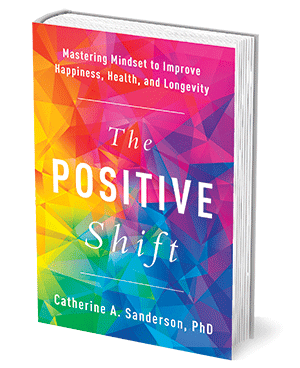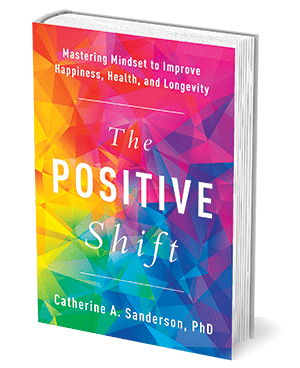
This year, the Amherst DeMott reading and lecture were centered around Poler Family Professor of Psychology Catherine Sanderson’s book, The Positive Shift: Mastering Mindset to Improve Happiness, Health, and Longevity. I sat down with her to ask a few questions inspired by the reading.
Could you start by describing what your book, The Positive Shift (TPS), is about?
“TPS is about how the power of mindset influences us in different ways, such as how we think about the world. It has implications for stereotypes about aging, as well as methods of thinking about health and pain. My favorite part [of the book] is how we can harness that information to make changes in our thoughts and behaviors to be happier and healthier.”
Is there a moment where you thought to yourself, ‘I have to write this book,’ or is there a moment when inspiration struck?
“I had been talking about the science of happiness a lot and giving public lectures about it. Every time I finished a talk, people would ask, ‘do you have a book?’ and I didn’t. Eventually, I got asked the question enough that I thought, ‘there is a need for it, there is a desire for it, and it would be fun to sit down and synthesize what this research is saying.’ So, it was really a gradual progression of people asking and me not having it, and finally carving out time to sit and write.”
Along the lines of there being a need for it, did you find before writing TPS that there was a real gap in actionable advice on happiness?
“There are frankly a lot of really great books about happiness…but a lot of those books focus specifically on ‘what do we know about happiness? What are the myths? What are the realities? What are the things we can do?’ What I really wanted to do in my book was have more of an academic focus, to really delve into the science part of it, and, in particular, to talk about the link between happiness and health. My earlier work focused on issues in Health Psychology, and a lot of the books on happiness took the popular press approach (i.e., self help-y), but I really wanted to focus on how happiness has real benefits in terms of health, pain, stress, and even longevity. I didn’t see another book out there that was doing all of those things.”
Shifting gears, at the beginning of the book, you talk about Positive Psychology as an emerging field (Sanderson 2019, 2), but obviously, people have been trying to find happiness since the beginning of time, so why do you think it’s such a contemporary field?
“When people think about psychology, they often think of the clinical field. They think of Dr. Phil, therapists, and Freud. The origins of psychology are focused on neuroses, depression, phobias, and problems. When I took Intro to Psychology in 1987 at Stanford, that’s what we learned about: problems. After I finished my undergraduate education, there was this real genesis of Positive Psychology. I think it’s a hopeful thing that even though the negative [aspects of psychology] got so much attention and much focus, we’ve really started trying to understand how to spend time, energy, and effort on engagement, meaning, contentment, satisfaction, and joy.”
At many points, you talk about the impact that mindset can have on physiology. How do you think doctors should use Positive Psychology? If there were someone at high risk for a heart attack or cardiovascular disease, should doctors prescribe a change in mindset, and if they do that, will they be taken seriously?
“When I started at Amherst in the fall of 1997, the very first class I taught was Health Psychology. Of course, a lot of this book is informed by my readings of the health literature, and I think similarly, there was something in the medical model called the biomedical model. [However,] the field of Positive Psychology has also shed tremendous light on how small things can matter in terms of medicine. For example, when doctors more convincingly believe in the treatment they’re giving you, the medicine works better. Strategies of meditation or giving can reduce blood pressure. So, yes, to me, all of this points to the benefits that changing mindset can have [in medicine]. This can mean making sure that hospital rooms have a view of nature instead of a parking lot. There is research showing you can recover faster from surgery this way.
There’s a new talk I’m giving now on the power and meaning of dogs. There’s a wonderful example I give at the end of the talk about a doctor who had a patient who was struggling, and he wrote a prescription that said, ‘get one golden retriever.’ [He did this] because we actually know that people who have dogs are happier and healthier for lots of different reasons. I love the idea that people are taking this seriously in the medical field in different ways. It’s not that you have to quit your job and move to Aruba; there are tiny things you can do in your everyday life that improve happiness.”
Relating to the little things you can do to improve happiness, you talk about how smiling can be the source of your joy sometimes instead of vice versa (Sanderson 2019, 81). Would you say that faking it until you make it is a legitimate way to achieve happiness?
“If you smile, even if you’re not happy, other people will smile back at you, and you get this instant feedback loop. Even the mere act of smiling changes how your body responds to pain. Now, I do think there are also limits to that. We also know that having authentic, meaningful relationships is really important. So I think to an extent faking it until you make it is a good idea, but a lot of the advice can get overblown. The idea that smiling will make your cancer go away is, of course, ludicrous.”
As a follow-up question, do you have advice about how to toe the line between a healthy mindset shift and toxic positivity?
“I think the idea of toxic positivity is really problematic because then people feel that if they’re not happy, it’s their fault. Instead, I like to talk about realistic positivity. Many of us at Amherst have this sense of doom and gloom (e.g. professors think, ‘if I get a paper rejected from a journal, I’m a horrible professor, and I’m not gonna get tenure,’ and students think, ‘I got a B on a paper, so I am a horrible student’). To think about things in a positive way is to learn from bad things that happen (e.g. ‘I should go back to the drawing board on my research idea’ or ‘I should use the Writing Center’). All the time in life, disappointments happen. People play poorly in a must-win game, and people have relationships end. The big question is not what happens to you – it’s how you can respond to that.”
Is there a specific takeaway you hope people remember? Is there one idea readers should be latching onto?
“The book ends with five chapters on strategies (behavior, nature, giving, spending on experiences, and relationships). I hope people will take away that happiness is not one size fits all. Maybe I don’t like running, but I really resonate with nature, or maybe I really don’t resonate with giving, but I really resonate with meditating. It’s really important for people to understand that what works for you might not work for your roommate, mother, friend, or colleague, and it’s up to each of us to decide how to best implement these strategies in our own lives.”
Is there anything else you’d like to add?
“I’m on Instagram @sandersonspeaking, where I talk regularly about life at Amherst, teaching, dogs, and positivity. I use social media as a chance to make connections with students, colleagues, parents, and friends. Anyone who finds more positivity in social media can follow me there!”

You must be logged in to post a comment.